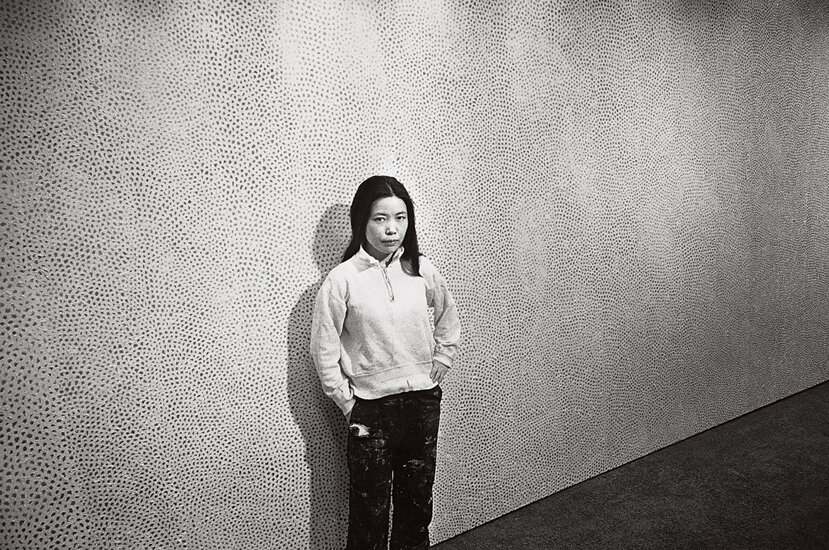You may already be aware of and completely in awe of Yayoi Kusama, the Japanese artist, who despite many personal difficulties is one of the most revered contemporary artists alive. Born on March 22nd 1929 in Matsumoto, Japan, Kusama was born into an affluent merchant family where her artist tendencies and creative disposition were completely unaccepted by her family. She began drawing and painting at a very early age and determined as she was, Kusama never steered off her path as a born-to-be artist. Enraged by her daughters most undesirable behaviours, something the family believed brought endless shame upon them, her mother would intentionally rip up her creations, leaving the young artist even more determined and purposeful. It was about this time that she admits to her hallucinations beginning. Involving vast expanses of open space, filled with polka dots, these imaginative delusions would prove to become the matter of her most iconic pieces and haunt her for the entirety of her life.
Despite much unrest and turmoil at home, she somehow persuaded her parents to allow her attend art school to study as a painter. It was at the Kyōto City Specialist School of Arts that she attained a not-so-influencial and brief training. Amid immense family conflict which very much hindered her yearning to work as an artist, she moved to New York city in 1957. Before immigrating, she destroyed much of her early work.
New York was her ticket to freedom, something she’d craved since childhood. There her obsessive repetition flourished and she began what she called her “infinity net” paintings - large canvases consisting of millions of tiny dots that she never let the edge of the canvas limit, their presence a reflection of the limitlessness of infinity. This early work was her contribution to the emerging Minimalist movement however her transition into performance art meant she was seen as a leader of the Pop art group soon after, a movement well-known of that time. She found herself at the centre of the city’s avant-garde scene and around this time her creations were beginning to gain major recognition, exhibited alongside some of the era’s most notable artists including Donald Judd, Andy Warhol and Claes Oldenburg.
At the height of the 60’s in New York, her work mirrored the issues of the time, especially her performance pieces which saw her touch on politic themes and society-induced limitations around homosexuality and the rights of women. She sought to be a voice for those who were silenced by the time’s controlling constraints. Her performance pieces were hugely successful, despite the many controversies surrounding them, what with her overindulgent use of nudity in public. Her public performances saw her arrested several times, yet these dangers never dampened desire to convey sensitive themes and her longing to help those she felt needed a platform from which they could be acknowledged and heard.
Her work has been shown in endless exhibitions around the world and is part of the permanent collections at the LACMA, the National Museum of Modern Art in Tokyo, MOMA in New York among many others. In 2014 and 2016 she was regarded as the most expensive artist. She has acquired world acclaim, both from those deeply imbedded in the the art world and those who, simply embarking upon a must-do visit to MOMA while in New York, tend to fall for her madly beautiful masterpieces.
Kusama never married, and amid the endless rumours that surrounded her and many of the artists she worked with during her time in New York, she only ever admitted to her relationship with Joseph Cornell, the legendary artist who, 25 years her senior, was an obsessively controlling figure in her life. The union was non-sexual though, in fact they never had sex and were simply bound by a pure love for almost a decade.
After Cornell’s death in 1977, her mental health deteriorated rapidly and she permanently relocated to her home country where she voluntarily checked herself into a psychiatric hospital; she resides there to this very day. She has remained an outsider to her peers ever since and, despite a certain self-consciousness, she keeps it that way. Her studio is across the road from the hospital where she works on new works, all while fighting the hallucinations and mental illness that have plagued her her entire life. Known as the ‘princess of polka dots’, the celebrated artist has known many hardships in her life. Turning her demons into something beautiful, her life is a story of survival and endurance and her art some of the most sought after pieces of her generation. Known for her mirror rooms, polka dots, mushrooms, pumpkins and at one time the repeated drawing of penises, her compulsion to repeat patterns is her way of dealing with her demons. Yet thanks to this unwavering desire to create, her desire to die has always been outweighed.















